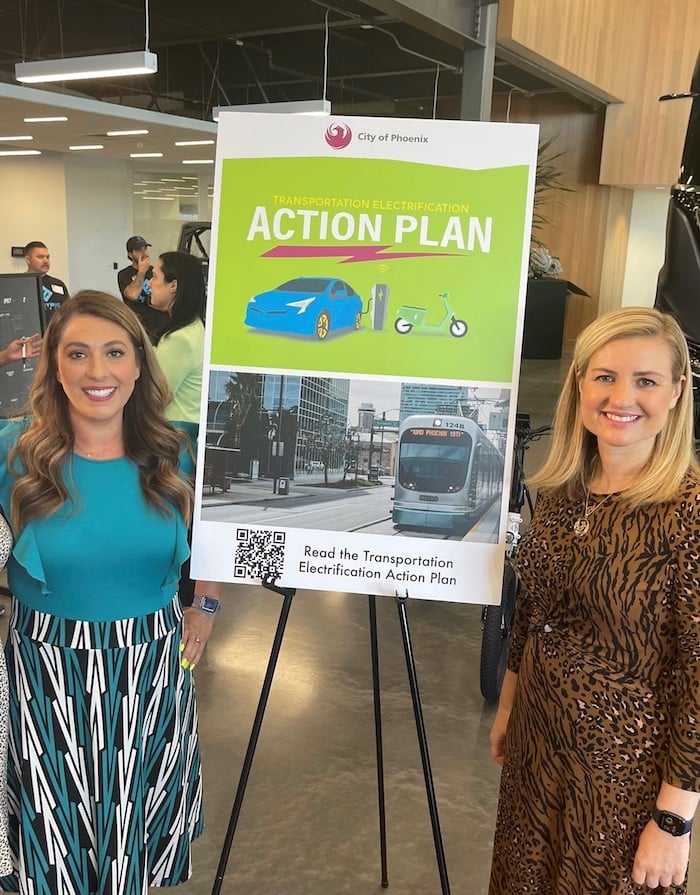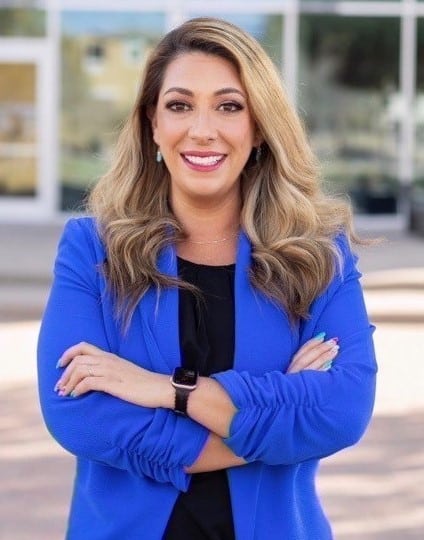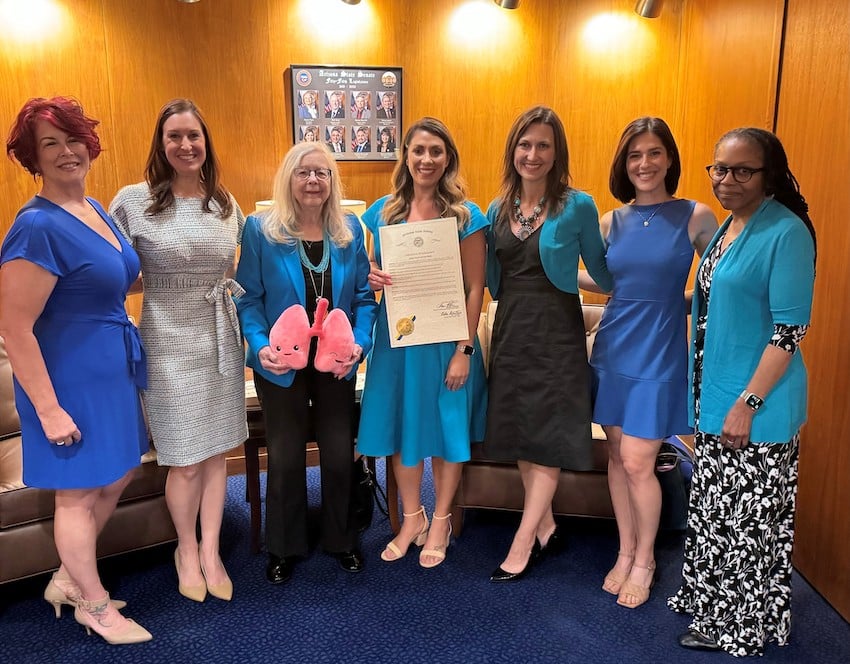BY PAM DELANY
Behind Phoenix’s abundant sunshine and beautiful landscapes hides an environmental and health crisis: air pollution. The city ranks among the most polluted in the nation, posing significant health risks to the public. JoAnna Strother, senior director of advocacy at the American Lung Association, is working to improve air quality in Arizona. With nearly two decades of experience in public health and policy advocacy, Strother is committed to reducing air pollution and promoting lung health.
According to the American Lung Association’s 2024 State of the Air report, Phoenix-Mesa is the fifth most ozone-polluted city in the United States. Additionally, the city ranks ninth for unhealthy levels of fine particle pollution (PM 2.5), a microscopic pollutant tiny enough to penetrate deep into the lungs.
Strother explains, “Our whole goal with the Lung Association is to educate people about what they’re breathing into their lungs. Part of that is to really work with our state decision-makers and lawmakers about things we can do here in Arizona to help offset the burdens.”
Phoenix’s air pollution is caused by several factors: The city’s geography, situated in a valley, allows pollution to become trapped due to temperature inversions, leading to prolonged exposure to harmful air. Traffic congestion due to urban sprawl and a growing population means more vehicles on the road, leading to higher emissions, especially during traffic standstills. Extreme heat and wildfires, intensified by climate change, worsen ozone levels and particle pollution. Even seasonal spikes during holidays like the Fourth of July and New Year’s Eve bring severe pollution from fireworks.

Ground-level ozone, also referred to as smog, is a colorless gas formed when pollutants react chemically with sunlight. Unique from the protective ozone layer in the upper atmosphere, this type of ozone develops near the Earth’s surface. It is most prevalent on warm, sunny days, especially in urban areas with heavy traffic and industry.
“Ozone acts like a sunburn to the lungs,” Strother says. While everyone is impacted by poor air quality, certain groups face heightened risks. According to Strother, children, seniors, pregnant women, and people with existing respiratory conditions like asthma or COPD are most vulnerable.
“When air quality levels reach the orange alert on the Air Quality Index, that means it’s already unhealthy for sensitive populations. But the reality is, no one is truly safe from the effects of breathing dirty air,” she explains.
Addressing air pollution requires both individual actions and systemic policy changes. Strother’s work at the American Lung Association is currently focused on advocating for zero-emission transportation policies, recognizing that the transportation sector is one of Arizona’s largest sources of pollution.
“Our goal is a transition to zero-emission vehicles, paired with a cleaner energy grid,” Strother says. According to the American Lung Association’s Zeroing in on Healthy Air report, a full-scale shift to zero- emission vehicles, such as electric vehicles, and clean energy by 2050 could result in $15.1 billion in public health benefits, a reduction in emergency room visits for asthma attacks, and fewer lost work and school days due to pollution-related illnesses.

Climate change exacerbates Arizona’s air pollution crisis by increasing the frequency of wildfires and extreme heat. Smoke from fires thousands of miles away travels to Arizona, decreasing air quality. Strother is currently partnering with CVS Health to launch a new initiative to educate individuals with lung disease about how climate change affects respiratory health.
“We want to make sure both patients and healthcare providers recognize the direct connection between climate change and lung health,” she explains. In addition to large-scale policy changes, Strother describes everyday actions that individuals can take to reduce air pollution. For example, refueling your car at night eliminates ozone, because ozone is produced when pollutants interact with heat and sunlight. Limiting idling while waiting in drive-thru lanes or school pick-up lines will decrease unnecessary air pollutants. When possible, using alternative modes of transportation such as walking, biking, carpooling, or public transit makes a powerful impact on lowering ozone levels. She also recommends limiting fire pits, burning, and fireworks, especially on no-burn days. Widespread, small-scale actions can make a difference.
The American Lung Association hosts several community events designed to increase awareness and raise funds that support its work. On April 5, 2025, the association will hold its Fight For Air Climb event at the Scottsdale Stadium. The event offers an opportunity for participants of all fitness levels to climb stadium stairs while raising funds and awareness for lung health. Another event that occurs each fall is the LUNG FORCE Walk, a family and dog-friendly 2.5-mile walk followed by food and music, games, and lung cancer education.
Strother’s work extends beyond air quality policies. Her advocacy contributed to a 2018 Arizona House Bill 2208, the Stock Inhaler for Schools program. The first legislation in the nation addressing asthma attacks in schools, the bill permits schools to purchase and administer albuterol sulfate inhalers to any child experiencing respiratory emergencies. According to Strother, children often experience their first asthma attack while at school, which means they do not have an inhaler with them.
“Before this law, if they didn’t have an inhaler, all schools could do was call 911 and hope for the best,” she shares. According to the Arizona Asthma Coalition, approximately 600 K-12 schools in Arizona have implemented the program with efforts to add 100 schools located in rural, medically underserved, and tribal nation communities.
Through its initiative, LUNG FORCE, the American Lung Association educates the public about lung cancer and the misperception that only those who smoke or have smoked are at risk. Lung cancer is increasingly diagnosed in individuals who have never smoked. The initiative “creates awareness about lung cancer while taking the stigma away around smoking and lung cancer,” Strother explains. Lung cancer might be the result of radon exposure or air quality.

“Sometimes, we just don’t know why people get lung cancer,” she says. Lung cancer screening, even in non-smokers, is critical to catching the disease in its early stages and increasing survival rates. Strother’s unwavering commitment to air quality and lung health continues to impact Arizona’s communities. Whether advocating for cleaner transportation policies, ensuring schools are equipped to handle asthma emergencies, or promoting lung cancer screenings, her work at the American Lung Association is a breath of clean, fresh air.






